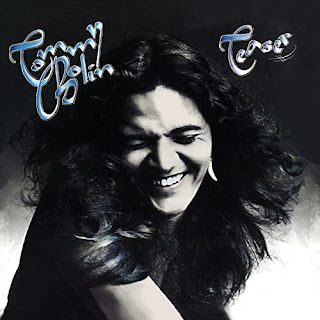Bolin subsequently forming the jazz-rock fusion outfit Energy (which never
recorded an album) before his immense talents would lead to high-profile gigs
with the James Gang and Deep Purple during the mid-to-late ‘70s. Bolin also
worked on sessions with fusion pioneers Billy Cobham (1973’s
Spectrum LP) and Alphonse Mouzon (1974’s Mind Transplant) and
provided guitar solos for Canadian hard rock outfit Moxy’s 1975 self-titled
debut.
When it came time for Bolin to record his first solo album,
1975’s Teaser, it was only natural that he’d infuse the performances
with elements of all of his disparate musical influences – hard rock, blues,
jazz fusion – with the results varying entirely on your taste for what Tommy
was dishing up. Recorded just prior to working on Deep Purple’s
Come Taste the Band, Teaser is, first and foremost, a showcase
for Bolin’s unique steel-string pyrotechnics. As such, it’s a somewhat schizo
affair, with the guitarist often changing stylistic directions even within a
song with whiplash accuracy.
Still, Teaser is an
entertaining, if uneven, collection of period rock ‘n’ roll. Album opener “The
Grind” is a boogie-flecked barrelhouse rocker with backing vocal harmonies,
rollicking instrumentation, and an overall ‘70s era musical sound and feel. By
contrast, “Homeward Strut” masterfully blends a hard rock soundtrack with
funky rhythms and a little jazzy swagger to create a lively instrumental with
definite New Orleans vibes. “Dreamer” skews a little too far into Elton John
territory for my taste, probably due to David Foster’s wimpy piano playing
while “Savannah Woman,” with its rhythmic Latin undercurrent, is a ‘yacht
rock’ attempt at making the charts better left to folks like Toto (whose Jeff
Porcaro plays drums on nearly every song on Teaser EXCEPT “Savannah
Woman,” where the stool is occupied by the Tubes’ Prairie Prince).
Thankfully,
the album’s title track mainlines some steroids with a hard rock soundtrack
upon which Bolin embroiders his fluid, razor-sharp guitarplay. The soulful
“People, People” displays Bolin’s emotional, albeit under-powered vocals, the
guitarist bringing in a bunch of jazz dogs like synth wizard Jan Hammer and
saxophonist Dave Sanborn to brass up the arrangement, which offers only the
slightest of six-string shadings. Bolin dives into the depths of jazz fusion
with “Marching Powder,” which brings in drummer Michael Waldon alongside
Hammer and Sanborn for a cacophonic instrumental that wouldn’t have been
out-of-place on a Cobham or Mouzon LP. Although the closer “Lotus” starts out
deceptively soft and kinda mushy, it soon powers up with a soaring guitar solo
before veering off again into more pastoral acoustic guitar strum and then
exploding once more with switchblade flash.
Much like the entirety
of Tommy Bolin’s too-short career (he would O.D. the following year after the
release of his sophomore effort, Private Eyes), the guitarist’s debut
album couldn’t figure out what direction it wanted to go, so instead it veered
all over the road. It makes for a thrilling, if somewhat unsatisfying ride,
but I’d still recommend either of Bolin’s solo albums for listeners looking
for a challenging perspective on guitar rock. (Nemporer Records, 1975)
Buy the CD from Amazon.com:
Tommy Bolin's Teaser
Friday, January 15, 2021
Classic Rock Review: Tommy Bolin's Teaser (1975)
Six-string wunderkind Tommy Bolin made his bones as a teenager playing
with the blues-rock band Zephyr in Boulder, Colorado. Although he provided his
stellar fretwork to that band’s self-titled 1969 debut album (Bolin was only
18), his restless muse prompted the guitarist to leave the band shortly after
the release of their 1971 album, Going Back To Colorado.
Subscribe to:
Post Comments (Atom)


No comments:
Post a Comment